Last Updated on January 8, 2024 by Greg Gillson
I’ve put this resource together for you to answer your question: What birds are in my backyard in Pennsylvania?
This article lists and discusses the identification of the most common birds in your backyard. The birds chosen in this article are compiled from actual data from the citizen science program eBird. Thus, it is more accurate than some other similar articles you may find on the web. I provide pictures of each bird species mentioned and I’ll tell how to attract them to your backyard.
These are the most common backyard birds in Pennsylvania:
- Northern Cardinal
- American Robin
- Mourning Dove
- Blue Jay
- American Crow
- Song Sparrow
- American Goldfinch
- Tufted Titmouse
- Downy Woodpecker
- Red-bellied Woodpecker
- European Starling
- White-breasted Nuthatch
- Carolina Wren
- House Finch
- Dark-eyed Junco
- House Sparrow
- Gray Catbird
- White-throated Sparrow
- Red-winged Blackbird
- Black-capped Chickadee
- Common Grackle
- Red-eyed Vireo
- Chipping Sparrow
- House Wren
- Barn Swallow
- Indigo Bunting
- Eastern Towhee
- Wood Thrush
- Cedar Waxwing
- Northern Flicker
Pennsylvania Birds and Birding in Pennsylvania State
eBird lists over 450 types of birds as occurring in the state of Pennsylvania.
The most common bird in Pennsylvania: the most frequently seen bird in the state is Northern Cardinal. It is reported on 50% of bird watching lists.
If you are serious about knowing the birds native to Pennsylvania, then check out eBird for Pennsylvania. It has recent sightings and photos, illustrated checklists with weekly abundance bar charts for state, counties, and individual hotspots of the best birding locations.
If you want to know about other people interested in birds in your area, join a local bird group. The American Birding Association maintains a list of bird watching clubs for each state
Pennsylvania Bird Identification
This section is the species accounts. These are designed to help you to recognize birds you see in your backyard. I have used eBird to select the birds that are most common. “Common” means the birds seen most often throughout the year, not necessarily the most numerous.
Each species account starts with a photograph. In the identification section I am using size and shape and bill type before considering the color or patterns on the birds. I find these more reliable when trying to identify an unknown bird. Pay attention to body and tail shape and especially bill shape of birds you see, not just plumage color.
In the section on bird feeders and foods I tell how to attract each species. Not all types of backyard birds will come to feeders. But all backyard birds can be attracted with water. So don’t forget to add a birdbath to your bird feeding station.
Do you live in northern Pennsylvania? Southern Pennsylvania? Eastern Pennsylvania? Western Pennsylvania? Central Pennsylvania? Or perhaps on one of the corners: northeastern Pennsylvania, northwestern Pennsylvania, southeastern Pennsylvania, or southwestern Pannsylvania?
To appear in this article, most birds are widely distributed throughout the state and are often year-round residents. However, for those birds that are more localized in place or time, I list the general region and seasonality. Please see the section following these species accounts for the lists of common species by season.
Even if a species is found in a general area, they occur only in the habitat they prefer. So, the exact habitat of your neighborhood is important for the presence of absence of certain kinds of birds.
1. Northern Cardinal (Cardinalis cardinalis)
This is one of the most common and popular backyard birds in the eastern half of the United States.
 |
| Northern Cardinal. GeorgeB2 from Pixaby. |
Range in Pennsylvania: Northern Cardinals are year-round residents throughout Pennsylvania.
Identification:
Size: Cardinals are a bit smaller than American Robins, about the same size as Red-winged Blackbirds.
Shape: Plump body with fairly long full tail. Wispy crest.
Bill: Short, heavy, conical, pink.
Color: That bright red color is matched by few other birds. Black face. The female is grayer, but with hints of red in wings and tail, and has a crest, too.
Habitat, range & behavior: Cardinals are year-round residents in shrubby woodland edges.
The occur from the eastern United States to Texas and Arizona south into Mexico.
That large conical bill is made for chewing seeds. Watch them crack open sunflower seeds, spit out the hulls, and pluck the kernel with their tongues!
Food and feeder preference: Black oil sunflower seeds. Many types of seeds, berries, nuts in larger hopper or tray feeders.
You may like my in-depth article on attracting Northern Cardinals.
2. American Robin (Turdus migratorius)
This familiar backyard bird is a resident in the northern half of the United States and a common winter visitor in the southern half.
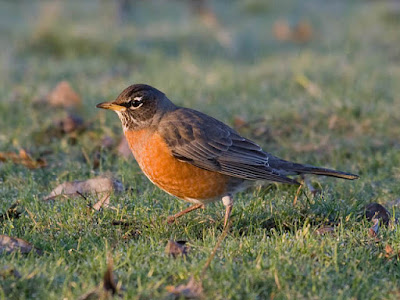 |
| American Robin. Greg Gillson. |
Range in Pennsylvania: American Robins are year-round residents throughout Pennsylvania.
Identification: This is a key species for comparing with an unknown bird.
Size: 10 inches long from bill tip to tail tip. About the same size as a Blue Jay or one of the Scrub-Jays. Larger than Red-winged Blackbird. Smaller than a Mourning Dove.
Shape: Very plump with a fairly long tail.
Bill: Straight and fairly slender, curved at the tip.
Color: Gray-brown upperparts, rusty orange breast.
Habitat, range & behavior: Open woodlands, farmlands, urban parks and lawns.
Migratory, breeds north across Alaska and Canada. Resident in most of the United States (lower 48). Winters in the United States, Mexico, to central America.
Hops on your lawn turning head this way and that looking for food. Their caroling song is one of the early signs of spring in the north.
Food and feeder preference: Worms and other invertebrates in the lawn. May eat fruit from a tray feeder or the ground. Eat small berries from trees and bushes.
3. Mourning Dove (Zenaida macroura)
Mourning Doves are the most widespread and most frequent backyard bird in the Lower 48 states of the United States.
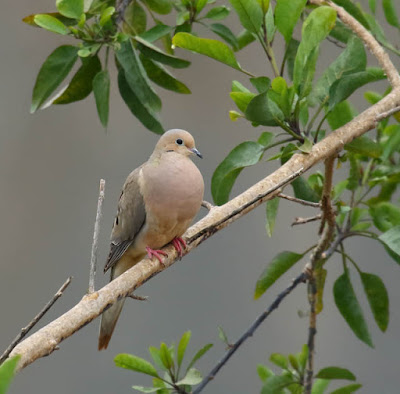 |
| Mourning Dove. Greg Gillson. |
Range in Pennsylvania: Mourning Doves are year-round residents throughout Pennsylvania.
Identification: This is a key species for comparing with an unknown bird.
Size: About 12 inches long from bill tip to tail tip. About same size as Northern Flicker. Larger than American Robin. Slightly smaller than domestic city pigeon.
Shape: Very plump with a small round head. Tail is long and pointed. Legs are short.
Bill: Small and rather slender.
Color: Pale brown-pink body, darker wings and tail. White edges on side of tail.
Habitat, range & behavior: Semi-open areas such as urban areas, farmlands, woods.
It is a resident across the lower-48 states and Mexico, with some movement out of northern areas in winter.
Often seen perched on wires, fences. Their mournful cooing is a familiar spring birdsong.
Food and feeder preference: Mourning Doves eat seeds almost exclusively. Attract with black oil sunflower seeds on a large sturdy tray feeder or on the ground.
4. Blue Jay (Cyanocitta cristata)
A common and well-known bird in the eastern half of the United States.
 |
| Blue Jay. Skeeze from Pixabay. |
Range in Pennsylvania: Blue Jays are year-round residents throughout Pennsylvania.
Identification:
Size: About that of American Robin.
Shape: Fluffy, large crested head, ample tail. Large strong legs.
Bill: Black, long and stout.
Color: Blue above, white below. Black neck collar. White patches in wing.
Habitat, range & behavior: Woodlands and towns.
Found in the eastern half of the United States. In summer into southern Canada. Bold and brash.
May bully smaller birds. Jays gulp lots of seeds or other food at once, storing it in their crop. Then they fly off and bury food items in a hidden cache.
Food and feeder preference: Omnivorous. They can quickly empty your feeder! Because they are also aggressive toward other feeder birds, some people put mesh cages around smaller bird feeders. Small birds can go through, squirrels and larger “pest” birds are prevented entry. Some people feed jays peanuts, perhaps away from the seed feeders.
5. American Crow (Corvus brachyrhynchos)
This larger all-black bird is common in cities and country. Its cawing call is familiar to most people.
 |
| American Crow. Greg Gillson. |
Range in Pennsylvania: American Crows are year-round residents throughout Pennsylvania.
Identification: This is a key species for comparing with an unknown bird.
Size: About 17-1/2 inches long from bill tip to tail tip, though there is much size variation throughout its range. Larger than blackbirds and grackles. Smaller than ravens.
Shape: Thick neck, large head, rather short square-ended tail. Longer legs. In flight has rounded wing tips with each primary feather separated from others forming “fingers.”
Bill: As long as head, thick, black.
Color: Glossy black throughout.
Habitat, range & behavior: They prefer open areas with trees, fields, farms, cities.
They are common across most of the United States lower-48, except in the desert southwest. They move into southern Canada in summer.
They gather in evening communal roosts in large flocks that may number into the thousands and then move out at dawn into the surrounding area.
Food and feeder preference: Omnivorous, they feed on large insects, grain, small mammals, carrion. You probably don’t want these large entirely black birds in your backyard feeders. So don’t feed table scraps to birds.
6. Song Sparrow (Melospiza melodia)
A common bird, but variable, and similar to many other streaked brown sparrows.
 |
| Song Sparrow. Greg Gillson. |
Range in Pennsylvania: Song Sparrows are year-round residents throughout Pennsylvania.
Identification:
Size: A smaller bird, similar in size to House Finch and juncos. Larger than chickadees and goldfinches. Smaller than White-crowned Sparrows or Spotted/Eastern towhees.
Shape: Plump with round head, long rounded tail.
Bill: Short, conical.
Color: Highly variable in darkness and color saturation across its range (dark rusty to pale gray). Generally gray-brown above with dark brown streaking on back. Complicated head pattern. Streaking on sides and breast converge into dense central breast spot.
Habitat, range & behavior: Thickets, especially near water. Backyard shrubbery.
Resident in western United States, western Canada, coastal southern Alaska, northeastern US. In summer also moves into mid-Canada and northern half of US. In the winter found in most of the US lower-48. Also, a population in central Mexico.
Forages on ground, never far from low cover to which they fly if startled.
Food and feeder preference: They feed on seeds and insects near the ground. Will visit hopper and tray feeders for mixed bird seed.
7. American Goldfinch (Spinus tristis)
A beautiful tiny finch familiar to many in backyards in its bright yellow summer plumage. Colloquially called a “wild canary.”
 |
| American Goldfinch. Greg Gillson. |
Range in Pennsylvania: American Goldfinches are year-round residents throughout Pennsylvania.
Identification: This is a key species for comparing with an unknown bird.
Size: Very small at about 5 inches from bill tip to tail tip. Similar in size to a chickadee. Larger than hummingbirds. Smaller than juncos and House Finches.
Shape: Tiny, somewhat plump with larger head and short tail.
Bill: Short, conical, pink.
Color: Males in summer are bright lemon yellow with black forehead and black wings and tail with white bars. White under tail coverts. Females are dull olive, wings and tail browner. Winter birds are pale grayish-yellow with tan and brown wings and tail.
Habitat, range & behavior: This species is found in weedy fields and similar clearings with thistles and similar plants.
It is found coast-to-coast throughout the year across most of the middle lower-48 states. In summer moves north to the Canada border. In the winter found south to the Mexico border.
The flight is highly undulating, rising and falling as they flap in short bursts. Besides a long, sweet lilting song, they call in flight a lilting 4-part: “potato chip!”
Food and feeder preference: Feeds on weed seeds, thistle seed. May eat black oil sunflower seeds from tube feeder. Attract with Niger seed in a feeder called a “thistle sock.”
You may like my in-depth article on attracting American Goldfinches.
8. Tufted Titmouse (Baelophus bicolor)
Related to chickadees, these common backyard birds lack the black bib, but have a crest instead.
 |
| Tufted Titmouse. Anne773 from Pixabay. |
Range in Pennsylvania: Tufted Titmice are year-round residents throughout Pennsylvania.
Identification:
Size: A small bird, but a large titmouse, this species is larger than chickadees, about the size of a junco or House Finch.
Shape: Rounded body, long full tail, big head, long legs.
Bill: Short and stout, compressed (taller than wide), black.
Color: Dark blue-gray above, pale below. Black feathers around eye accentuates its size.
Habitat, range & behavior: Lives in deciduous forests with heavy canopy, parks.
Found in eastern and southeastern United States is expanding its range north and west.
Backyard bird feeders might be helping this species expand its range northward.
Food and feeder preference: Insects and seeds. At your hopper or tray feeder attract with black oil sunflower seeds and suet.
9. Downy Woodpecker (Dryobates pubescens)
This tiny woodpecker is common in backyards across the United States.
 |
| Downy Woodpecker. Greg Gillson. |
Range in Pennsylvania: Downy Woodpeckers are year-round residents throughout Pennsylvania.
Identification:
Size: Bigger than a junco or House Finch. Smaller than a Red-winged Blackbird. About the same size as a White-crowned Sparrow, but with a much shorter tail.
Shape: Stocky with large head and short stiff tail.
Bill: Short, chisel-shaped.
Color: Black-and-white striped head. Black wings with white spots. Solid white back. White under parts. Black tail with white outer tail feathers with black bars or spots. Male with small red spot at back of head.
Habitat, range & behavior: Found in small deciduous trees, willows, and even weed stocks such as teasel, especially near water.
Ranges coast-to-coast across all but northernmost parts of Canada and Alaska south to the southern US. Absent in the desert southwest.
Interestingly, I learned today that the males may more often be found in smaller plants and twigs, while females are more likely on tree trunks.
Food and feeder preference: Insects, fruits, and seeds. Gleans arthropods from the bark of trees. Attract with suet feeder. Will also eat black oil sunflower seeds.
10. Red-bellied Woodpecker (Melanerpes carolinus)
This is one of the most common species in the eastern half of the United States.
 |
| Red-bellied Woodpecker. Skeeze from Pixabay. |
Range in Pennsylvania: Red-bellied Woodpeckers are year-round residents throughout most of Pennsylvania, absent in northeastern Pennsylvania.
Identification:
Size: Fairly large for a backyard bird. Between a Starling and American Robin in size. Smaller than a Northern Flicker.
Shape: Stout with large head and short tail. Clings to tree trunk on strong short legs propped up with short stiff tail.
Bill: Long, chisel-shaped.
Color: Pale gray body, many thin black-and-white bars across back and wings. Red nape, extending forward on crown on male.
Habitat, range & behavior: These birds are found in many woodland types, including oak, hickory and pine.
They are found from the eastern slope of the Rocky Mountains in the lower-48 states from Texas to extreme southern Canada, and eastward from Florida northward just to the southern edge of the New England states.
In typical woodpecker fashion, it hitches up the tree trunk and larger branches.
Food and feeder preference: This species eats insects and nuts. They may eat peanuts from a tray feeder and eat from a suet block.
11. European Starling (Sturnus vulgaris)
Introduced to North America in the late 1800’s, they crossed the continent, often to the detriment of native cavity-nesting birds. The prime example of an invasive species.
 |
| European Starling. Greg Gillson. |
Range in Pennsylvania: European Starlings are year-round residents throughout Pennsylvania.
Identification: This is a key species for comparing with an unknown bird.
Size: 8-1/2 inches from bill tip to tail tip. About the size of a Red-winged Blackbird. Smaller than an American Robin. Larger than a White-crowned Sparrow or Spotted/Eastern towhee.
Shape: Stocky with large head, short square-ended tail. Longer legs.
Bill: As long as head. Sharp pointed. Yellow in spring, otherwise dark.
Color: They are grayish brown much of the year, with glossy iridescence and white spotting during the spring.
Habitat, range & behavior: Lowland birds that need trees large enough for nest cavities but plenty of open area for feeding. They are most abundant in urban and suburban areas where they find food and artificial nest cavities.
Resident from coast-to-coast from southern Canada to northern Mexico. In summer north across Canada and Alaska. Native range is Europe to Pakistan, north Africa.
Often viewed as a pest, starlings often bully other backyard birds, taking over bird feeders, and stealing nest cavities from smaller native birds. In winter they can form into flocks of ten’s of thousands.
Food and feeder preference: Primarily insects when available, often feeding on the ground. Discourage them from your backyard hopper and tray feeders by never feeding birds table scraps (including bread or meat). They have weak feet and do not perch well on tube feeders. A cage mesh around smaller hopper feeders may keep them out.
12. White-breasted Nuthatch (Sitta carolinensis)
A favorite backyard feeder bird for many for its active antics and fearlessness. Though a small bird it is the largest nuthatch in North America.
 |
| White-breasted Nuthatch. Greg Gillson. |
Range in Pennsylvania: White-breasted Nuthatches are year-round residents throughout Pennsylvania.
Identification:
Size: About chickadee-sized in length. Smaller than a junco or House Finch.
Shape: Appears large-headed, neckless, very short tailed. Short legs.
Bill: Nearly as long as head, straight, thin.
Color: Blue-gray above, white below. Black cap, wing tips, tail. Rusty feathers under tail.
Habitat, range & behavior: Common in oak and oak-pine woodlands, wooded towns. Absent from treeless grasslands, deserts in the west.
Found across the United States, southern Canada, mountains of central Mexico.
Crawls over tree branches and head-first down tree trunks searching for insects.
Food and feeder preference: Insects, seeds, acorns and other nuts. Attract with black oil sunflower seeds feeding on hopper and tray feeders. Suet blocks.
13. Carolina Wren (Thryothorus ludovicianus)
This is a fairly common backyard bird in the much of the eastern United States.
 |
| Carolina Wren. theSOARnet from Pixabay. |
Range in Pennsylvania: Carolina Wrens are year-round residents throughout Pennsylvania.
Identification:
Size: A smaller bird, between the size of American Goldfinch and House Finch.
Shape: Round body, short neck, flat head, long tail flipped about actively.
Bill: Fairly long, thin, pointed and slightly curved.
Color: Upper parts rusty brown with black bars on the wings and tail. A white eyebrow line and buff under parts.
Habitat, range & behavior: Shrubby thickets and brushy suburban yards.
It is found in the southeastern United States and Yucatan. Northern parts of range expand and contract depending upon harshness of winters.
Males sing throughout the year and are very loud for their size.
Food and feeder preference: Feed mostly on insects and spiders. They will feed on suet.
14. House Finch (Haemorhous mexicanus)
Originally a bird of the West, now found across most of the US. There are other red finches, but these common birds are the ones most likely in residential areas.
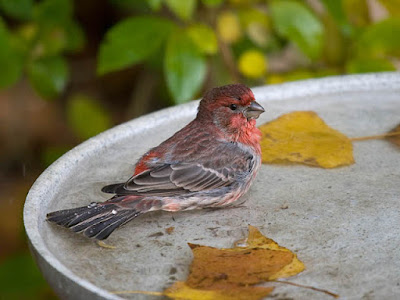 |
| House Finch. Greg Gillson. |
Range in Pennsylvania: House Finches are year-round residents throughout Pennsylvania.
Identification: This is a key species for comparing with an unknown bird.
Size: About 6 inches from bill tip to tail tip. Larger than goldfinches and chickadees. Smaller than a White-crowned Sparrows or Spotted/Eastern towhees.
Shape: Medium build with a medium-long notched tail. Round head.
Bill: Short, conical.
Color: Brown and gray above with streaks on the sides of the pale underparts. Males with red (sometimes orange or rarely yellow) crown, chest, rump.
Habitat, range & behavior: You’ll find small flocks on wires, in short tree tops and in bushes. Originally deserts and grasslands. Rural areas and towns are where they’re now most common.
Formerly found in the western United States and Mexico. Then introduced into the northeastern United States, but now found in nearly all of the lower-48 states and extreme southern Canada. Rare in plains states (Dakotas to Texas) and southern Florida.
House Finches are not territorial, but males sing throughout the year–a lively, wiry song ending in a couple of buzzy notes.
Food and feeder preference: They love sunflower seeds and tube feeders. May eat from thistle socks.
15. Dark-eyed Junco (Junco hyemalis)
Colloquially called “snowbirds,” they often arrive in backyards in winter from nearby mountain forests or more northern climes.
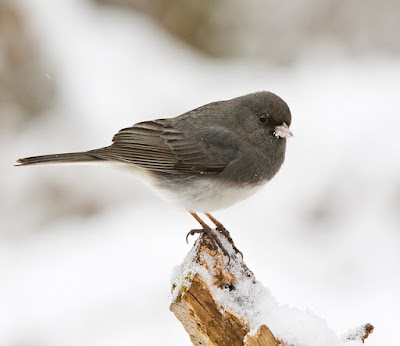 |
| Dark-eyed Junco. Skeeze from Pixabay. |
Range in Pennsylvania: Dark-eyed Juncos are year-round residents in northern and south central Pennsylvania, winter visitors only in southwestern and southeastern Pennsylvania.
Identification:
Size: Small birds about the size of a House Finch.
Shape: Round body, short neck, round head, fairly long square-ended tail.
Bill: Short, pointed, conical, pink.
Color: Eastern birds are a darker all-gray with white belly. Western birds have jet black hood over their head, brown back, and pink sides.
Habitat, range & behavior: Breed in coniferous forests. Winters widely. Avoids heavy brush, preferring widely spaced bushes.
Breeds across most of Canada, Alaska, and the western half of the United States. Winters from southern Canada and all of the lower 48-states to extreme northern Mexico.
Spend much of their time hopping and feeding on the ground.
Food and feeder preference: Eats mostly seeds, also insects in summer. Readily feed at backyard feeders on mixed seeds on hopper or tray feeders and ground.
You may like my in-depth article on attracting Dark-eyed Juncos.
16. House Sparrow (Passer domesticus)
Like the starling, this is another bird introduced from Europe in the 1800’s. This sparrow is commonly found in cities and farmlands. It is considered a pest in most areas where it has been introduced.
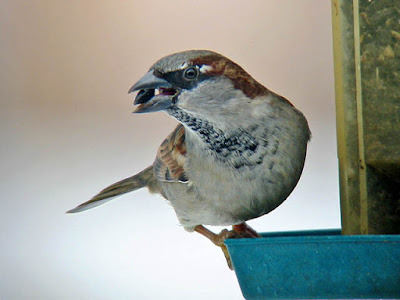 |
| House Sparrow. Greg Gillson. |
Range in Pennsylvania: House Sparrows are year-round residents throughout Pennsylvania.
Identification:
Size: The size of a House Finch or Dark-eyed Junco.
Shape: Chunkier than native North American sparrows with large head, barrel chest, short neck, medium tail, short legs.
Bill: Short, conical.
Color: Males are brown and gray with a black mask. Females lack the black and are tan and brown with a pale line back from the eye.
Habitat, range & behavior: Cities and farms.
Range in North American from southern Canada through Central America. In summer northward through Canada to southern Alaska. Originated in Middle East and spread to most of Europe and Asia. Introduced in South America, Africa, Australia–nearly anywhere there are people and cities.
They tend to be messy… and have a good appetite and may occur in large noisy chirping flocks. They are aggressive toward other feeder birds.
Food and feeder preference: They eat grain, seed, and insects. To discourage them from your hopper and tray feeders do not feed birds human food scraps. They have a bit of difficulty eating from tube feeders.
17. Gray Catbird (Dumetella carolinensis)
This bird is rather common where it occurs, but a bit secretive.
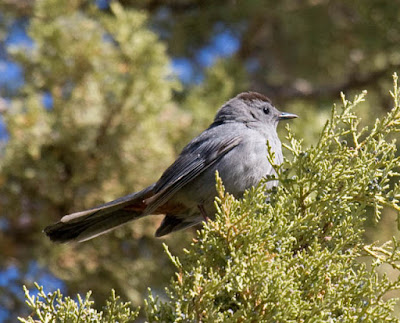 |
| Gray Catbird. Greg Gillson. |
Range in Pennsylvania: Gray Catbirds are summer residents throughout Pennsylvania, year-round residents in southeastern Pennsylvania.
Identification:
Size: About the length of a Red-winged Blackbird or Northern Cardinal.
Shape: Long tailed, round head.
Bill: Medium-length, pointed.
Color: Gray with a black tail and black cap. Rusty under tail coverts.
Habitat, range & behavior: Dense woodland edges, scrub, abandoned orchards.
Breeds in eastern and central US and adjoining southern Canada. Winters in extreme south US Gulf states, southward in eastern Mexico to Panama.
They spend much time hopping on the ground or in low bushes. They defend a winter territory, unlike most birds.
Food and feeder preference: Insects and berries. You may attract this species with jelly and fruit feeders, suet, and water.
18. White-throated Sparrow (Zonotrichia albicollis)
A fairly common bird of northern forests that visits backyards across much of the US.
 |
| White-throated Sparrow. Greg Gillson. |
Range in Pennsylvania: White-throated Sparrows are year-round residents in northern Pennsylvania, winter visitors throughout.
Identification:
Size: Similar in size to White-crowned Sparrow. Bigger than a House Finch; smaller than a starling.
Shape: Longer body. Round head on short neck. Long tail with notched tip.
Bill: Short. conical.
Color: Striped tan and brown above, pale gray below. White-striped form with black and white head stripes. Tan-striped form with tan and brown striped head. First year birds are similar to tan-stiped adults, but streakier overall. Yellow spot between eyebrow and bill. White throat strongly offset from gray breast and face.
Habitat, range & behavior: Found in forests, brush, and open woodland edges.
Breeds across Canada and northernmost Eastern United States. Winters in the eastern US, southern central US, and rare but regular along the West Coast.
Found in small flocks on ground near brush into which they can flee. Kick up leaves to search under for food.
Food and feeder preference: Eat seeds and berries in winter, more insects and fruit in summer. In your feeder attract with mixed seeds on a platform feeder and on the ground.
19. Red-winged Blackbird (Agelaius phoeniceus)
These noisy flocking birds are most often found in marshes. But in winter they are found in backyards.
 |
| Male Red-winged Blackbird. Greg Gillson. |
 |
| Female Red-winged Blackbird. Greg Gillson. |
Range in Pennsylvania: Red-winged Blackbirds are year-round residents throughout Pennsylvania.
Identification: This is a key species for comparing with an unknown bird.
Size: About 8-3/4 inches long from bill tip to tail tip. About the size of a Northern Cardinal. Smaller than an American Robin.
Shape: Pot-bellied with a longer bill and flat forehead. Tail average.
Bill: Long and sharp pointed.
Color: Males are black with red and yellow shoulder patch. Females are streaked brown and rusty (sparrow-like but pointed bill and flat forehead).
Habitat, range, and behavior: Cattail marshes and wetlands are their summer habitat. In winter they feed in grain fields.
They breed across most of the North American continent. In winter they withdraw from most of Alaska and Canada.
They are found in colonies in summer and large flocks in winter.
Food and feeder preference: They eat insects in summer. In winter they eat grain and seeds. They visit feeders, more often in large winter flocks, and eat most seeds and suet.
20. Black-capped Chickadee (Poecile atricapillus)
These are common backyard birds in the northern half of the United States.
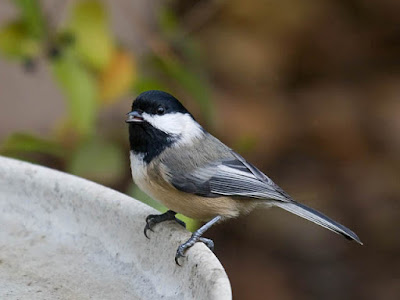 |
| Black-capped Chickadee. Greg Gillson |
Range in Pennsylvania: Black-capped Chickadees are year-round residents throughout most of Pennsylvania, absent in southeastern part of state.
Identification:
Size: Chickadees are small birds, the same general size as an American Goldfinch.
Shape: Round body, big round head, long tail with rounded tip.
Bill: Short, straight, stout.
Color: Gray above, buffy below. Black cap and bib with white lower face. White edges on wing feathers.
Habitat, range & behavior: Deciduous and mixed forests.
They range from the northern half of the United States, southern half of Canada, and most of Alaska.
Small flocks flit actively from tree to tree acrobatically gleaning insects from twig tips. In winter chickadees make up the core of mixed-species flocks also containing nuthatches, kinglets, creepers, woodpeckers and others.
Food and feeder preference: Seeds, insects, berries. They eat at tube, hopper and tray feeders. Attract with black oil sunflower seeds and suet.
You may like my in-depth article on attracting Black-capped Chickadees.
21. Common Grackle (Quiscalus quiscula)
Sometimes considered a pest to crops, grackles are longer and lankier than very similar blackbirds.
 |
| Common Grackle. GeorgiaLens from Pixabay |
Range in Pennsylvania: Common Grackles are year-round residents throughout Pennsylvania.
Identification:
Size: Larger than Red-winged Blackbirds, they are near the length of Mourning Doves.
Shape: Long, with long full keel-shaped tail, long legs, flat crown.
Bill: Longer than head, pointed, but stouter than other blackbirds.
Color: Glossy black with hint of bronze or green on head (depending upon population). Yellow eye.
Habitat, range & behavior: They are found in agricultural areas, woodland edges, city parks and lawns.
Resident in the southeastern United States. In summer they migrate northward and west to the central United States and Canada.
They monopolize feeders and are bullies toward other birds.
Food and feeder preference: Grain, corn, acorns, small aquatic fish and amphibians. To discourage them, use tube feeders, rather than hopper or tray feeders. Don’t over-feed, keep spilled seed picked up.
22. Red-eyed Vireo (Vireo olivaceus)
This is one of the most common songbirds in eastern woodlands.

Range in Pennsylvania: Red-eyed Vireos are summer residents throughout Pennsylvania.
Size: Small, about the size of an American Goldfinch. Smaller than a House Finch.
Shape: Long and slim, but with rather short tail. Big-looking head.
Bill: Longer, stout. Pointed but small hook on end, as all vireos.
Color: They are olive-green above, white or with a hint of yellow below. Gray crown, bordered by black line, white eyebrow, and another thin black line through red eye.
Habitat, range & behavior: Tall deciduous trees, such as cottonwoods.
Breed across Canada, the Rocky Mountains and most of the East. Absent from much of the West and Southwest.
As with many vireos, they sing persistently through the summer and through the heat of the day, not just primarily during spring and at dawn as many other songbirds.
Food and feeder preference: They eat insects and will not come to feeders.
23. Chipping Sparrow (Spizella passerina)
Chipping Sparrows are a common and widespread species adapted to human disturbance. They are rather tame. They are frequently found in cemeteries with large trees.
 |
| Chipping Sparrow. Greg Gillson. |
Range in Pennsylvania: Chipping Sparrows are summer residents throughout Pennsylvania.
Identification:
Size: These are small sparrows, bigger than goldfinches or chickadees, but smaller than House Finches or Song Sparrows.
Shape: Plump and fairly long tailed.
Bill: Short and conical.
Color: Striped brown and dark brown above. Grayish under parts. Black line through eye. Crown streaked in winter but in summer becomes solid chestnut. Two white wing bars.
Habitat, range & behavior: Grassy open conifer woodlands with some shrubs, parks, orchards.
Breeds from Alaska, across Canada and south into highlands of Middle America. In winter retreats from northern areas to southern United States and northern Mexico.
In summer solitary or in pairs. In winter they forage in flocks of up to 50 birds.
Food and feeder preference: Weed seeds, supplemented with insects in summer. They may eat black oil sunflower seeds in your feeder, but more likely will feed on mixed seeds on the ground under the feeder.
24. House Wren (Troglodytes aedon)
These backyard birds will readily use nest boxes to raise their young.
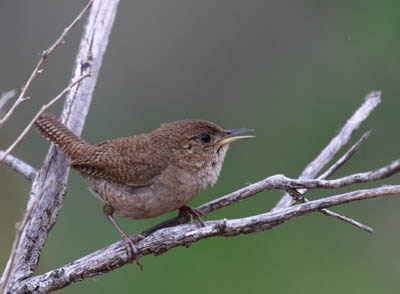 |
| House Wren. Greg Gillson. |
Range in Pennsylvania: House Wrens are summer residents throughout Pennsylvania.
Identification:
Size: About the size of Black-capped Chickadee but with shorter tail.
Shape: Round body. Large head. Thin short tail.
Bill: Fairly long, thin, slightly down curved. Sharply pointed.
Color: Rather dull brownish-gray throughout. Paler throat and breast. Tail barred with black and pale bars along with the brown.
Habitat, range & behavior: Brushy areas, woodland edges, hedge rows, tree stumps in logged areas.
Breed across Canada and the northern and mid-latitudes of the United States. Winter to the southern United States and through Mexico. Found year round at southern edge of breeding range: California, North Carolina to northern Alabama, southern Arizona south through mountains of Mexico.
Stay hidden in brushy areas. Hop among tree roots, logged stumps.
Food and feeder preference: May feed at suet feeder.
25. Barn Swallow (Hirundo rustica)
These common swallows are widely distributed throughout the world, primarily breeding in the northern hemisphere, and wintering in the mid-latitudes and southern hemisphere.
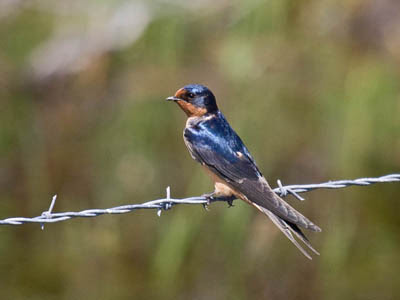 |
| Barn Swallow. Greg Gillson. |
Range in Pennsylvania: Barn Swallows are summer residents throughout Pennsylvania.
Identification:
Size: About the size of a House Finch but with a much longer tail.
Shape: Stocky, short necked but with long body and tail. Tail is forked, with very long outer tail feathers. Wings pointed.
Bill: Short, wide.
Color: Glossy dark purplish-blue above. Pinkish-orange below.
Habitat, range & behavior: Barn Swallows live in open country, frequently near humans. Farmlands. Nest in barns, under small bridges.
In North America breed from Mexico to northern Canada and Alaska, wintering from southern Mexico throughout most of South America.
Frequently seen swooping low over the ground hunting flying insects. Perch on wires, fences. Voice is twitters and chirps with grating sounds.
Food and feeder preference: Eat flying insects on the wing and are not attracted to backyard feeders.
26. Indigo Bunting (Passerina cyanea)
Don’t mistake Indigo Buntings for the larger Blue Grosbeak. As the name suggests, the grosbeak has a much larger and thicker bill, along with rusty wing bars, lacking in Indigo Buntings.

Range in Pennsylvania: Indigo Buntings are summer residents throughout Pennsylvania.
Identification:
Size: These birds are a bit smaller than a House Sparrow.
Shape: Plump. Large round head. Medium short tail.
Bill: Large and conical.
Color: Males are deep blue. Females are pale gray-brown with diffuse streaks below.
Habitat, range & behavior: Open woodlands and clearings. Country farm roads.
They are found in the East and parts of the Southwest, north to southern Canada.
Sing from the tallest tip of tree or telephone lines, a cheerful paired bouncy song very similar to American Goldfinch. In fact, they are sometimes called “blue goldfinches” because of this!
Food and feeder preference: These birds will eat seeds from hopper feeders, perhaps more so in the late spring when they first arrive during migration.
27. Eastern Towhee (Pipilo erythrophthalmus)
These birds were formerly lumped with Spotted Towhee as one species, Rufous-sided Towhee. Together they were found across the United States, they now split the country in half, east and west.
 |
| Eastern Towhee. Skeeze from Pixabay. |
Range in Pennsylvania: Eastern Towhees are summer residents throughout Pennsylvania.
Identification:
Size: Just a bit larger than a White-crowned Sparrow.
Shape: Chunky or pot-bellied with a big round head and full rounded tail.
Bill: Stout and conical.
Color: Black hood and upper parts, including tail. White wing path. White tail corners. Rusty sides. White belly. Females replace the black with dark brown.
Habitat, range & behavior: Brushy woodland edges. Tangles.
Breeds throughout the eastern United States and adjacent southernmost Canada. Northern populations migrate out of the northern US to the Southeast.
These birds spend much of their time on the ground, kicking up leaf litter with both feet in a hop-kick.
Food and feeder preference: These birds eat a wide variety of insects, beetles, berries, and seeds. They will feed on the ground under your feeder or on platform feeders. Attract with black oil sunflower seeds and other seeds.
28. Wood Thrush (Hylocichla mustelina)
A rusty forest bird of the eastern United States. A favorite songster.
 |
| Wood Thrush. Tony Castro. CC BY-SA 4.0 |
Range in Pennsylvania: Wood Thrushes are summer residents throughout Pennsylvania.
Identification:
Size: Just smaller than a Red-winged Blackbird. Between a sparrow and robin in size.
Shape: Plump with longer legs.
Bill: Pointed, but fairly thick.
Color: Rusty orange above. White eye ring. Black spots on white breast.
Habitat, range, and behavior: Found in deciduous and mixed woodlands.
Breeds in the eastern United States and adjacent southern Canada. Winters from southern Mexico to Panama.
The spend much of their time hopping on the ground, shuffling through the leaf litter.
Food and feeder preference: Don’t visit feeders.
29. Cedar Waxwing (Bombycilla cedrorum)
Waxy red tips to the wing feathers give these backyard birds their unique name. Maybe it’s the fancy crest. Maybe it’s the bandit mask. Maybe it’s the yellow band at the tip of its tail. But these are one of my favorite birds.
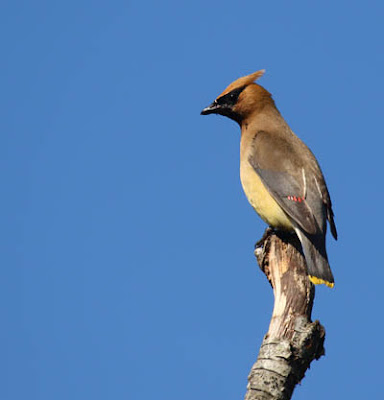 |
| Cedar Waxwing. Greg Gillson. |
Range in Pennsylvania: Cedar Waxwings are year-round residents throughout Pennsylvania.
Identification:
Size: Smaller than European Starling. Larger than House Sparrow.
Shape: Similar to European Starling. Rather stocky. Short squared tail, but long under tail coverts. Large head. Pointed wings. Wispy crest.
Bill: Rather short, small, wide.
Color: Warm brown above with wispy crest. Black mask. Yellowish belly. White under tail coverts. Gray wings. Gray tail with yellow tip.
Habitat, range, & behavior: Deciduous woods, wooded streams and lakeshores, residential shade trees, fruit orchards.
Resident across the northern US. Summer resident in Canada. Winter visitor throughout all of US and Mexico.
Keep in tight flocks. Feed in trees and large bushes for berries. Fly catch over ponds and streams.
Food and feeder preference: Berries and flying insects. Usually don’t come to feeders unless fruit like cherries offered but will visit bird baths.
30. Northern Flicker (Colaptes auratus)
Of all the bird identification questions I get asked, this common larger backyard bird is the bird most people ask about. It doesn’t occur to those unfamiliar with it that this could be a woodpecker.
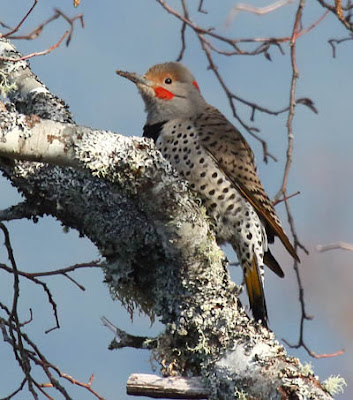 |
| Northern Flicker. Greg Gillson. |
Range in Pennsylvania: Northern Flickers are year-round residents throughout Pennsylvania.
Identification:
Size: About the size of a Mourning Dove. Larger than a robin.
Shape: Stocky with short legs, short tail, big head.
Bill: As long as head, thin, slightly curved.
Color: Back is brown with black bars. Under parts pinkish with black spots. Undersides of black wing and tail feathers are bright salmon red (West) or yellow (East). Head gray (West) or brown (East) and males with red (West) or black (East) whisker marks and nape marks (East). Black crescent across chest. White rump seen in flight.
Habitat, range & behavior: Found in woodland edges and forests.
Year-round resident from extreme southern Canada, across all of the lower-48 states and in the mountains of Mexico and Middle America. In summer breeds northward well into Canada and Alaska.
Frequently noted hopping on ground pecking in the ground for insects. In late spring, males proclaim their territory by rapid pounding on a hollow tree branch, though the ringing of metal downspouts at dawn is louder and carries much farther, to the exasperation of anyone trying to sleep inside!
Food and feeder preference: Ants and beetles are their primary foods. Will eat black oil sunflower seeds and are attracted to suet.
Common Birds in Pennsylvania
To determine how common each species is I used the data from actual bird sightings from the citizen science program eBird. Birds are listed by frequency. That is, how often the species is recorded on checklists submitted to eBird (a percentage).
When choosing the birds to include in this article I leaned strongly to birds that are present throughout the year in good numbers. Thus, many of the common birds are year-round residents. This means that they live in the same location all year. They raise their young in your neighborhood. They don’t migrate. Or if the species does migrate, the ones living in your area don’t. If this is the case, some migrants may move into your area during certain times of year, adding to the same species that are in your yard full time.
Some migrant birds visit your yard during the “summer.” Often, they arrive in spring and remain until late fall. They nest and raise their young in your neighborhood. These are the summer residents.
Other migrant birds visit your backyard during the “winter.” Some of these winter visitors may arrive in July and remain into April. Others may only be found in the cold of December or January. They key here is that they nest and raise their young somewhere else. They only visit your yard in the non-breeding season.
Migration is an amazing spectacle.
There will be birds that fly through your region in spring or fall (or both). They may visit your backyard only a few days or weeks a year. They aren’t regular enough, or stay long enough, to be included in this article. But the number of briefly visiting migrant birds could double the number of species presented here. You may see them over time. Consult checklists in eBird for your county to see what is possible.
I have generally excluded common waterfowl, birds of prey, shorebirds, seabirds, and others that aren’t usually found in residential areas. But they may certainly fly over or be seen regularly if your home is on a shoreline, for instance.
Most common backyard birds in Pennsylvania throughout the year
The following list is the backyard birds that are, on average, most common throughout the entire year. The list is ordered by most common based on the frequency of how often each species is recorded on checklists submitted to eBird.
- Northern Cardinal (50% frequency)
- American Robin (43%)
- Mourning Dove (42%)
- Blue Jay (42%)
- American Crow (42%)
- Song Sparrow (37%)
- American Goldfinch (35%)
- Tufted Titmouse (33%)
- Downy Woodpecker (33%)
- Red-bellied Woodpecker (31%)
- European Starling (29%)
- White-breasted Nuthatch (28%)
- Carolina Wren (26%)
- House Finch (24%)
- Red-winged Blackbird (24%)
- Dark-eyed Junco (22%)
- House Sparrow (21%)
- Gray Catbird (21%)
- White-throated Sparrow (20%)
Most common backyard birds in Pennsylvania in winter
- Northern Cardinal (45% frequency)
- Dark-eyed Junco (44%)
- American Crow (38%)
- Downy Woodpecker (37%)
- Mourning Dove (36%)
- Tufted Titmouse (36%)
- Blue Jay (34%)
- White-breasted Nuthatch (33%)
- White-throated Sparrow (30%)
- Red-bellied Woodpecker (30%)
- European Staling (28%)
- House Finch (27%)
- Song Sparrow (26%)
- Carolina Wren (25%)
- House Sparrow (23%)
- Black-capped Chickadee (20%)
Most common backyard birds in Pennsylvania in summer
- American Robin (62% frequency)
- Northern Cardinal (48%)
- Gray Catbird (47%)
- Mourning Dove (47%)
- Song Sparrow (45%)
- American Goldfinch (39%)
- Blue Jay (38%)
- American Crow (38%)
- Red-winged Blackbird (35%)
- Red-eyed Vireo (31%)
- Chipping Sparrow (31%)
- Common Grackle (30%)
- European Starling (28%)
- Tufted Titmouse (26%)
- House Wren (26%)
- Downy Woodpecker (24%)
- Red-bellied Woodpecker (24%)
- Barn Swallow (24%)
- Indigo Bunting (23%)
- House Finch (23%)
- House Sparrow (23%)
- Carolina Wren (23%)
- Eastern Towhee (22%)
- Wood Thrush (22%)
- Cedar Waxwing (21%)
- Northern Flicker (20%)
- White-breasted Nuthatch (20%)
How do Pennsylvania birds in winter differ from birds throughout the year as a whole?
American Robins and American Goldfinches are less common in winter.
Dark-eyed Juncos and Black-capped Chickadees are more common in winter.
How do birds in summer differ from birds throughout the year as a whole?
American Robins and Gray Catbirds are much more common in summer.
American Goldfinches are more common in summer.
Several species are only found in summer as compared with winter: Red-eyed Vireo, Chipping Sparrow, House Wren, Barns Swallow, Indigo Bunting, Wood Thrush.
Common Backyard Birds of Philadelphia, Pennsylvania
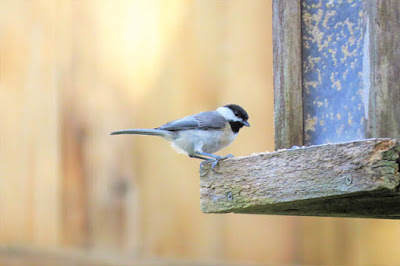 |
| Carolina Chickadee. GeorgeB2 Pixabay |
- American Robin (63% frequency)
- Northern Cardinal (57%)
- Mourning Dove (48%)
- Song Sparrow (47%)
- European Starling (45%)
- Downy Woodpecker (41%)
- Carolina Wren (41%)
- Carolina Chickadee (40%) Learn about this species on eBird
- American Goldfinch (39%)
- House Sparrow (37%)
- Blue Jay (35%)
- Gray Catbird (33%)
- Red-bellied Woodpecker (33%)
- White-throated Sparrow (33%)
- American Crow (27%)
- Tufted Titmouse (27%)
- Northern Flicker (27%)
- House Finch (23%)
- Tree Swallow (23%)
- Common Grackle (22%)
- White-breasted Nuthatch (20%)
Carolina Chickadee appears quite high on this list, even though they don’t appear on any other of the lists of common backyard birds in Pennsylvania.
Carolina Wrens are more common in the Philadelphia region than the state as a whole.
European Starlings and House Sparrows average higher frequency than the state average, no doubt due to the more urban habitat.
Blue Jays and White-breasted Nuthatches, birds that like open woodlands, are a bit less regular than the state average.
Common Backyard Birds of Pittsburgh, Pennsylvania
- Northern Cardinal (46% frequency)
- Blue Jay (40%)
- American Robin (39%)
- Song Sparrow (38%)
- Mourning Dove (34%)
- Tufted Titmouse (33%)
- American Crow (33%)
- American Goldfinch (29%)
- Red-bellied Woodpecker (28%)
- Carolina Wren (28%)
- Downy Woodpecker (26%)
- European Starling (21%)
- House Sparrow (21%)
- House Finch (21%)
- White-breasted Nuthatch (21%)
The common birds in Pittsburgh mirror the common birds in the state of Pennsylvania as a whole.
Wrapping Up
Philadelphia has some amazing backyard birds and if you venture further out into the wilds, it can offer stunning waterbirds and breath taking raptors in some of the best bird watching areas in the country.
Water birds:
- Great Blue Heron: Standing tall and regal along rivers and lakes, these large wading birds with long necks and blue-grey plumage often fish for prey.
- Canada Goose: Honking flocks of these large migratory geese are a common sight on waterways, sometimes even taking up residence in parks and urban ponds.
- Wood Duck: Vibrant and colorful, these dabbling ducks with iridescent plumage frequent freshwater habitats, diving for food and nesting in hollow trees.
Birds of prey:
- Red-tailed Hawk: These soaring raptors with broad wings and rusty-red tails patrol the skies, scanning for prey like rodents and small birds.
- American Kestrel: Smaller and more agile than their hawk cousins, kestrels hover in mid-air before diving down to catch insects and lizards.
- Eastern Screech-Owl: These camouflaged owls with piercing eyes and ear tufts hunt small mammals and insects at night, often heard near wooded areas.
Places to birdwatch in Philadelphia:
- John Heinz National Wildlife Refuge: A haven for migratory birds, offering diverse habitats like marshes, meadows, and woodlands.
- Bartram’s Garden: This historic garden boasts a variety of native plants and attracts an array of bird species.
- Fairmount Park: Philadelphia’s largest park offers several ponds, wooded areas, and open spaces with diverse birdlife.
- Schuylkill River Trail: Perfect for riverside birding, with sightings of waterfowl, herons, and raptors.
Frequently Asked Questions
Are Philadelphia vireos rare?
Yes, Philadelphia vireos can be considered rare across much of their range, including in Philadelphia itself. Here’s a breakdown of why:
Globally:
- They have a relatively small breeding range, primarily concentrated in boreal forests of Canada.
- Their populations are estimated to be in the low tens of thousands.
- They face threats like habitat loss due to logging and climate change.

In Philadelphia:
- They are not common breeders within the city limits, though they do occasionally nest in suitable woodland habitats.
- They are primarily seen as migrants in spring (late April-May) and fall (late September-October).
- Even during migration, they can be difficult to spot due to their small size, cryptic coloration, and preference for the upper canopy.
However, there are some nuances to consider:
- In certain areas with suitable habitat conditions, like the northern Great Lakes region, they can be locally common during migration.
- Their populations seem stable at present, thanks to conservation efforts focused on protecting their boreal breeding grounds.
Here’s a quick comparison of rarity categories for context:
- Common: Seen regularly in suitable habitats.
- Uncommon: Seen occasionally in suitable habitats.
- Rare: Difficult to find, even in suitable habitats.
- Vagrant: Very rare occurrence outside of their usual range.
Based on this, Philadelphia vireos fall into the “rare” category within Philadelphia itself. However, if you’re lucky and persistent, you might just catch a glimpse of these elusive birds during their migratory stopover in the city.
What is the state bird of Pennsylvania?
Pennsylvania actually doesn’t have an official state bird in the traditional sense! Instead, it has a designated “state game bird” – the ruffed grouse.
The ruffed grouse was chosen for this distinction back in 1931 due to several reasons:
- Historical significance: It played a vital role as a food source for early settlers and continues to be a popular game bird in the state.
- Abundance: It was (and still is) a fairly common inhabitant of Pennsylvania’s diverse forests.
- Uniqueness: Its cryptic coloration, drumming displays, and explosive take-off behavior make it a fascinating and challenging bird to observe.
However, it’s important to note that while the ruffed grouse holds this special designation, it doesn’t have the same protected status as an official state bird. Hunting regulations are in place for ruffed grouse within Pennsylvania.

What is the new bird in Pennsylvania?
Ah, the “tanabeak”! This fascinating hybrid bird found in Pennsylvania has attracted a lot of attention. Here’s what you need to know:
The tanabeak is not a new species, but rather a rare hybrid. Discovered in western Pennsylvania in 2020, it is a cross between a Scarlet Tanager (male) and a Rose-breasted Grosbeak (female). It’s affectionately called the “tanabeak” because its physical characteristics and song combine elements of both parent species.
This is the first-ever documented hybrid of its kind, making it a unique and exciting discovery for ornithologists and birders alike. The finding sheds light on the potential for hybridization between certain bird species under the right conditions.

The tanabeak has a distinctive appearance:
- Body: Size and shape similar to a Rose-breasted Grosbeak.
- Plumage: Mixes the black, red, and yellow of the Scarlet Tanager with the brown and white streaking of the Rose-breasted Grosbeak.
- Song: Combines elements of both parent species’ songs, making it a unique and interesting mix.
Unfortunately, there haven’t been any recent confirmed sightings of the tanabeak. The initial sighting was in 2020, and with hybrids being rarer than purebred birds, encountering one again can be challenging. However, birdwatchers in Pennsylvania and surrounding areas keep their eyes peeled for this fascinating feathered creature.
Overall, the tanabeak is a reminder of the incredible diversity and adaptability of nature. Even within established species, fascinating combinations can emerge, adding to the richness of the bird world.
________________________________________________________________________________________________
Related Articles:
Feeding winter birds in Pennsylvania
My review of the Nikon Monarch 7 8×42: I recommend these as the best birding binoculars under $500.
How about my recommendation for the best binoculars under $100 suitable for backyard bird watching.
Would you like me to set up your bird feeding station for you? Here are my recommendations for you!
Learn about the 7 different kinds of bird feeders and the different birds they attract
Looking for some bird identification tips? 7 Steps to accurately identify birds










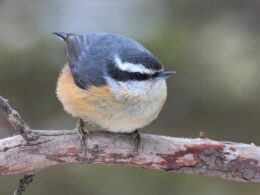
Fantastic summary Greg, I can't believe nobody commented, well done!
Thank you!